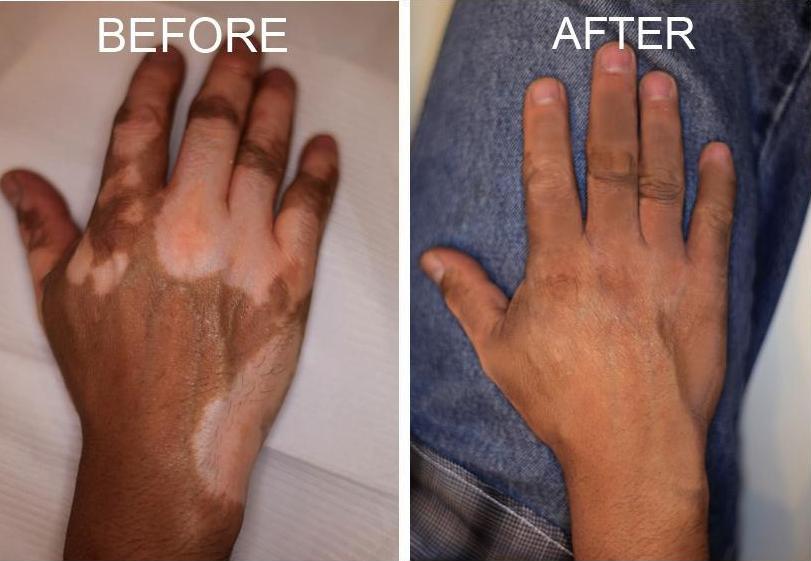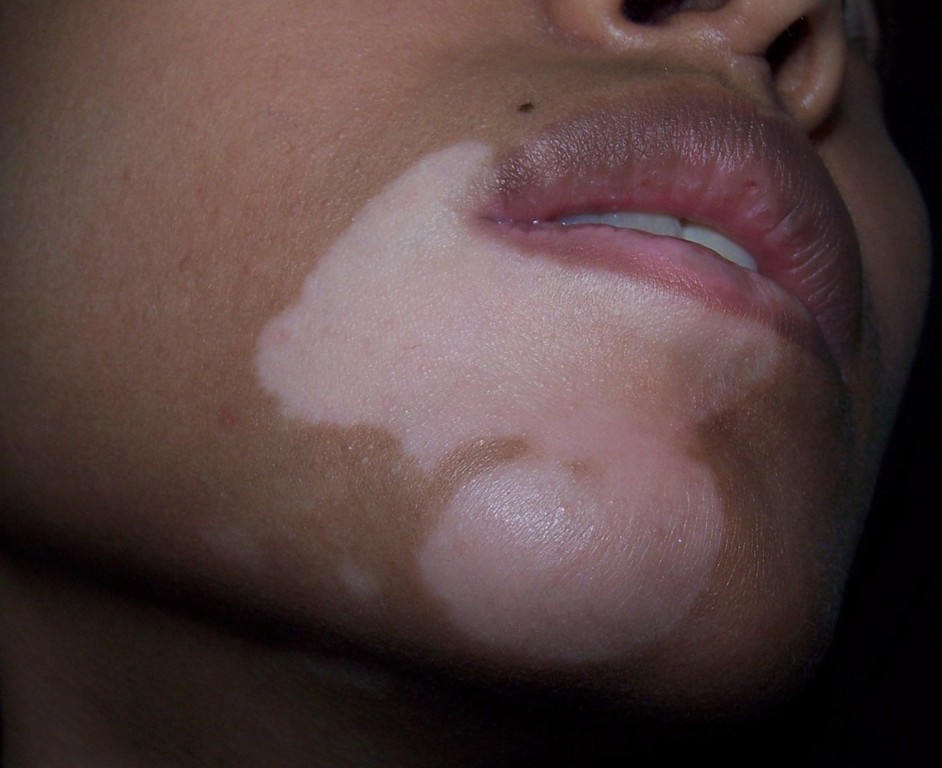What is Vitiligo?
Vitiligo is an autoimmune skin disease in which there is a progressive destruction of the skin’s pigment-producing cells (melanocytes), resulting in areas of otherwise normal white skin devoid of melanin pigment. It is not unusual for hairs growing in areas of vitiligo to lose their normal color.
The total area of skin that can be affected by vitiligo varies between individuals. It can also affect the eyes, the inside of the mouth, and the hair. In most cases, the affected areas remain discolored for the rest of the person’s life. The condition is photosensitive. This means that the areas that are affected will be more sensitive to sunlight than those that are not.

It is hard to predict whether the patches will spread, and by how much. The spread might take weeks, or the patches might remain stable for months or years. The lighter patches tend to be more visible in people with dark or tanned skin.
What Are Signs, Symptoms & Causes of Vitiligo?
Classical vitiligo can begin anytime after birth and often appears as a white spot without other symptoms on a background of normally pigmented skin. The only detectable change in affected areas is the loss of color, which can begin with lightning but will progress to complete loss of color. If vitiligo involves hair-bearing areas, it is not unusual to note the development of gray, pigment-free hair growing from involved follicles. There may be one or more of these patches that may gradually enlarge and rarely progress to involve the entire skin surface.

There are clinical subtypes of vitiligo that extend in a linear fashion down an entire limb (segmental vitiligo). Vitiligo often involves the genitalia and is predisposed to appear in areas of previous skin trauma. Obviously, completely depigmented skin can be much more cosmetically significant in those with racially darker pigmentation. Skin affected by vitiligo is particularly susceptible to sunburn and chronic sun damage.
Causes of Vitiligo:-
Vitiligo occurs when melanin-forming cells fail to produce melanin pigment.
- It may be due to immune system disorder in which person’s immune system reacts against the body’s own organs or tissues.
- Heredity may be a factor.
- Some people have reported a single event, such as sunburn or emotional distress, that triggered the condition.
- Sometimes pigment loss can occur in someone who has had a melanoma.
- Vitiligo is more common in people with certain autoimmune conditions such as Hyperthyroidism, Alopecia areata, Pernicious anemia.
Symptoms of Vitiligo:-
- Pigment loss produces milky white patches on skin.
- Premature whitening of the hair on scalp,eyelashes.eyebrows,beard.
- Loss of the colour of the tissue that lines the inside of the mouth.
- Loss of colour of the inner layer of the eyes.
- Depigmentation firstly appear on the sun exposed areas of skin such as hands,feet,arms ,face and lips.Genitalia may also affected.
- A few people say that the skin affected by vitiligo itches or feels painful.
Types of Vitiligo
To easier explain this condition, scientists have separated vitiligo in basically two types which are called: nonsegmental, and segmental vitiligo.
Non-Segmental Vitiligo:
It is the most common type of vitiligo and occurs in up to 90% of the people who have this disorder.

In non-segmental vitiligo, the patches often become visible equally on both sides of the body, with some kind of symmetry. These unusual symmetrical patches most commonly appear on skin that is exposed daily to the sun, such as the face, neck, and hands, but it also appears on these other areas:
- backs of the hands
- arms
- eyes
- knees
- elbows
- feet
- mouth
NON-SEGMENTAL VITILIGO HAS SUB-CATEGORIES:
- Generalized Vitiligo: the most familiar pattern, it has no specific area or size when the white patches start occurring.
- Acrofacial Vitiligo: This type of vitiligo is considered only when the appearance is mostly on the fingers or toes.
- Mucosal Vitiligo: The appearance of the depigmentation generally around the mucous membranes and lips.
- Universal Vitiligo: It is very rare since depigmentation has to cover most of the body.
- Focal Vitiligo: one or a few scattered white patches in small certain areas. It is often noticeable in young children
Segmental Vitiligo:-
Segmental Vitiligo has a different form of appearance. This condition spreads more rapidly, but is considered more constant and stable than non segmental. It is definitively much less common, and it affects only about 10% of people with this condition. But unpredictably, segmental vitiligo is more noticeable in the early ages affecting about 30% of the children that have been diagnosed with vitiligo.

It is non-symmetrical and usually tends to affect dorsal roots of the spine. It is more stable, less erratic, and responds well to topical treatments.
CONSULT Our DERMATOLOGIST
Consults our dermatologist to recover your skin condition.You can visit our website for more details or Make an appointment with our Doctors.

